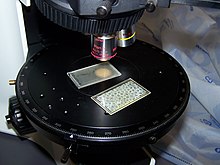
Back شريحة رقيقة Arabic Шліф Byelorussian Làmina prima Catalan Dünnschliff German Lámina delgada (geología) Spanish Õhik Estonian Lame mince French Շլիֆ Armenian Sezione sottile Italian 薄片 Japanese



In optical mineralogy and petrography, a thin section (or petrographic thin section) is a thin slice of a rock or mineral sample, prepared in a laboratory, for use with a polarizing petrographic microscope, electron microscope and electron microprobe. A thin sliver of rock is cut from the sample with a diamond saw and ground optically flat. It is then mounted on a glass slide and then ground smooth using progressively finer abrasive grit until the sample is only 30 μm thick. The method uses the Michel-Lévy interference colour chart to determine thickness, typically using quartz as the thickness gauge because it is one of the most abundant minerals.
When placed between two polarizing filters set at right angles to each other, the optical properties of the minerals in the thin section alter the colour and intensity of the light as seen by the viewer. As different minerals have different optical properties, most rock forming minerals can be easily identified. Plagioclase for example can be seen in the photo on the right as a clear mineral with multiple parallel twinning planes. The large blue-green minerals are clinopyroxene with some exsolution of orthopyroxene.
Thin sections are prepared in order to investigate the optical properties of the minerals in the rock. This work is a part of petrology and helps to reveal the origin and evolution of the parent rock.
A photograph of a rock in thin section is often referred to as a photomicrograph.
Thin sections are also used in the microscopic study of bones, metals and ceramics.
© MMXXIII Rich X Search. We shall prevail. All rights reserved. Rich X Search